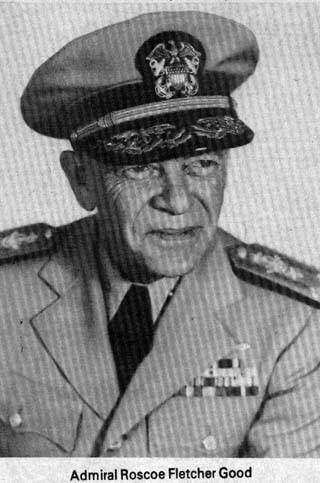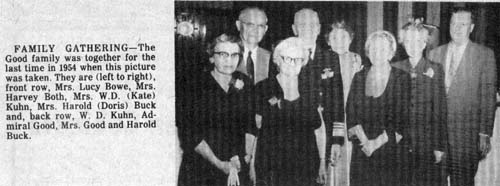January 11, 1979


Picture #1 – A 1954 photo of Admiral Good, his wife, and Admiral Good’s four sisters.
(EDITOR’S NOTE:) This is another in the series of articles about former Fostorian’s who grew up here. The purpose of the articles is two-fold…to inform older readers about old friends and acquaintances, and to let younger readers know about those Fostorians who have achieved successful careers… hopefully to inspire and encourage them.
Admiral Good was Fostoria’s highest ranking naval officer. He also attained the honor of serving in two world wars as well as the Korean conflict. Many other service honors were awarded him in the 42 years that he served his country.
“Fletch” Good, as he was known to many Fostorians, was born in Fostoria March 13, 1897, and graduated from Fostoria High School in 1914. For two years after graduation he was a reporter and advertising solicitor for The Fostoria Daily Times.
In 1916 Good received an appointment to the U.S. Naval Academy. Before he completed his training there he was drafted into service during World War I in 1919 and served for six months aboard the USS Wyoming, USS New Jersey, as part of the Atlantic fleet. He was returned to the academy to graduate with his class in 1920, standing fourth in a class of 452. He was editor of his class paper “Lucky Bag.”
SUBMARINE DUTY
His marriage to Bess Louise Owen, a Fostoria girl, took place Aug. 2, 1919, aboard the USS Columbia, the ship to which he was assigned for three years after graduation from the academy. After that he had submarine training and was assigned to the USS O-12 in August 1921. His sea duty continued as commanding officer of USS L-9 and XO, USS S-21. In 1922 he was commanding officer USS S-17 in Panama.
In June 1924 he began postgraduate instruction in diesel engineering in Annapolis and continued at Columbia University, from which he received his MS degree in 1926. Good had three more years of submarine duty before reporting to Bureau of Engineering. From 1930 to 1932 he was submarine superintendent at the New York Navy Yard. He then joined Sub Div. 10 in the USS S-37 until May 1935 in the Far East.
After two years as officer in charge of the Internal Combustion Engine Laboratory at the Naval Engineering Experimental Station, Annapolis, he reported as navigator of the USS Arkansas.
COMMANDER PACIFIC FLEET
Good served on the USS Tuscaloosa for a year before joining the staff of Commander Cruise Battalion Force in June 1939. In February, 1941 he transferred to the staff of Commander in Charge of Pacific Fleet as assistant operations officer, stationed in Hawaii. He received the Legion of Merit for service in that capacity.
In August 1943, Good reported for staff duty with commander in charge U.S. fleet and chief of naval operations. In October 1944 he was assigned to the USS Washington and took command of her the next month. For meritorious con- duct in battle in that command he was awarded a Gold Star in lieu of the second Legion of Merit with Combat “V”, and a letter of commendation with ribbon.
Admiral Good became commander of Cruiser Division Six in July 1945. In Novem- ber of that year he reported to the Office of Chief of Naval Operations as head of the Fleet Operation (Logistics), stationed in Germany.
Three years later (1956) he reported as commander naval forces Far East (later Japan).
Admiral Good retired March 1, 1956, and settled in Foley, Ala., where several other naval officer friends also lived. As a civilian he was a civil and mechanical engineer. He had expected to do some fishing and enjoy retirement, but his health failed and he and his wife were forced to move to McLean, Va., where he died in February 1973 at Bethesda Naval Hospital. He was buried with full military honors in Arlington Cemetery.
First Lieutenant Roscoe F. Good III, the only child of the Goods, was killed in action in Korea, 1951.
ADDRESSED TOLEDO MEETING
The last participation of Admiral Good in public ceremonies in this area was 1954 in Toledo for Armed Forces Day. For that event he was introduced by Rear Admiral R. W. Carey, USN (Retired), holder of the Congressional Medal of Honor.
Good’s remarks at that event was not a speech, but a report on “Power for Peace,” in which he described how the nation’s defenses were being modernized to keep abreast of the needs for the future, when sabotage and air attack would be possible in the event of total war.
Present at the Toledo meeting was Good’s four sisters, shown in the accom- panying photo with the admiral and his wife. That was the last time his entire family were together. Since then three of the sisters, Mrs. W.D. (Kate) Kuhn, Mrs. Harvey Roth and Mrs. Lucy Bowe have followed their brother in death. The two brother-in-laws, W.D. Kuhn and Harold Buck have also died. Mrs. Buck, the only remaining sister, now resides in Athens, Ga.
Other Fostorians present at the Toledo ceremonies to hear Admiral Good were Mr. and Mrs. E.M. Hopkins and Mr. and Mrs. Harry Stoneberger.